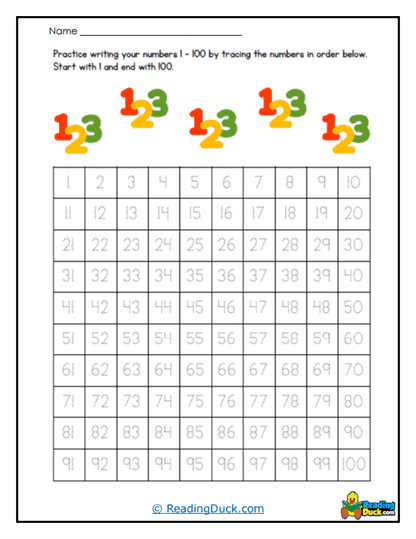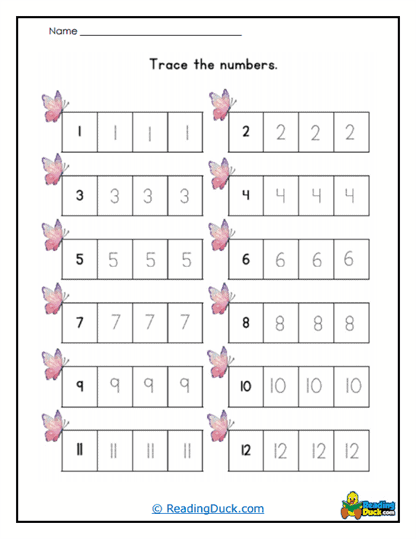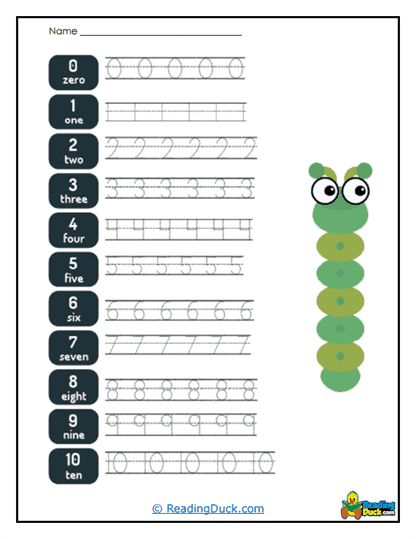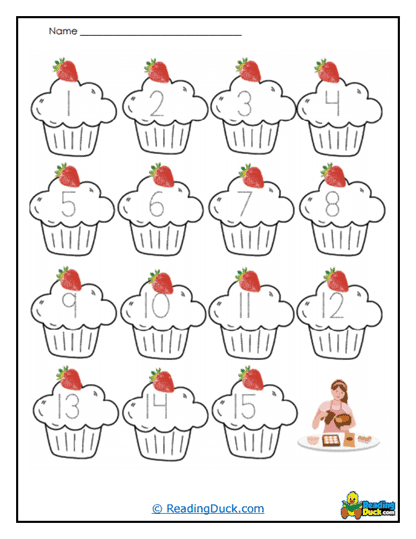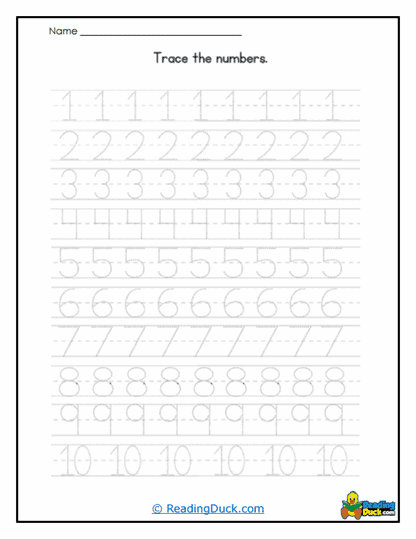Number Tracing Worksheets
About Our Number Tracing Worksheets
Our Number Tracing Worksheets offer young learners a structured approach to developing the foundational skills needed for writing numbers with accuracy and confidence. Falling under the Handwriting category within the Skills section, this collection focuses on helping students improve their fine motor skills, hand-eye coordination, and ability to form numbers correctly. By tracing numbers repeatedly, students strengthen their pencil control and prepare themselves for writing numbers independently. These worksheets are presented in a convenient PDF format, making them easy to view, download, and print for both classroom and home use. Each worksheet is also accompanied by a downloadable answer key, enabling parents and educators to provide guidance and monitor progress.
What is Number Tracing? A Detailed Exploration
Number tracing is an educational activity designed to help young learners master the art of writing numbers by providing a visual and tactile guide for proper number formation. Tracing allows students to follow a pre-drawn number, guiding their hands through the motions needed to write each numeral correctly. This process not only reinforces the correct formation of each number but also helps build the muscle memory necessary for writing them independently.
Key Components of Number Tracing:
- Structured Number Formation: Number tracing worksheets provide clear, pre-drawn numbers that serve as a visual guide for students. Each number is designed to show the proper direction and sequence of strokes, ensuring that students learn to form the numbers consistently and accurately.
- Fine Motor Skill Development: Writing numbers requires fine motor control, and number tracing activities help students refine their ability to hold and move a pencil precisely. By repeatedly tracing numbers, students improve their hand strength, coordination, and dexterity, all of which are essential for writing fluently.
- Visual and Tactile Learning: Number tracing engages both visual and tactile learning modalities. Students see the number they are tracing, which reinforces their ability to recognize numerals, while simultaneously practicing the physical act of writing the number. This multi-sensory approach helps solidify the connection between the visual appearance of the number and the motor movements required to write it.
Examples of Number Tracing:
- Single Numbers: At the earliest stages, students trace individual numbers, such as 1, 2, or 3, focusing on the correct formation of each numeral.
- Sequential Numbers: As students advance, they practice tracing numbers in sequence, such as 1 through 10 or even larger sets, helping them develop a stronger sense of number order and counting.
Benefits of Number Tracing:
- Consistency in Writing: Tracing numbers helps students form each numeral with the same shape and size, improving the consistency of their handwriting. This consistency is important for legibility and sets the stage for future writing tasks.
- Pencil Control and Handwriting Fluency: As students gain more control over their pencil movements through tracing, they become more confident in their ability to write numbers independently. This fluency will later translate into greater ease when writing larger numbers, solving math problems, or engaging in other writing activities that involve numbers.
How These Worksheets Support Number Writing Skills
The Number Tracing Worksheets are designed to give young learners ample practice in recognizing, forming, and writing numbers. These worksheets are structured to provide both repetition and guidance, allowing students to build their skills incrementally and achieve mastery over time.
Support for Number Recognition and Formation:
- Visual Models for Learning: Each worksheet includes clear, traceable models of the numbers, offering students a guide to follow as they practice writing. The visual reference allows students to see what the number should look like, ensuring they form it correctly each time.
- Guided Practice for Number Formation: The worksheets are designed to help students focus on the mechanics of writing each number. Through guided tracing, students learn where to start each number, the direction of the strokes, and how to complete each number efficiently and neatly.
- Repetition for Skill Reinforcement: Repetition is key to developing strong handwriting skills, and these worksheets offer numerous opportunities for students to trace and write each number multiple times. This practice helps solidify the motor movements required to form each number and reinforces the correct techniques for number writing.
Building Confidence in Writing Numbers:
- Gradual Skill Progression: The worksheets are designed to gradually increase in complexity, starting with basic number tracing and moving toward more advanced exercises that may involve tracing numbers in sequence or writing numbers independently after tracing them. This allows students to build confidence as they move from simple to more challenging tasks.
- Encouraging Independent Writing: Once students have practiced tracing the numbers and gained control over their pencil movements, they are encouraged to write the numbers on their own. This progression helps develop their ability to write numbers independently, a skill that will be essential as they move on to more advanced math and writing tasks.
The Role of Number Tracing in Early Literacy and Numeracy Development
Number tracing plays a significant role in the development of early literacy and numeracy skills. While it primarily focuses on handwriting and number formation, the activity also supports other foundational skills that are crucial for academic success.
Developing Numeracy Skills:
- Number Recognition and Identification: Tracing numbers reinforces students' ability to recognize and identify numerals, which is a key aspect of early numeracy development. As students practice tracing each number, they become more familiar with its shape and can more easily recognize it in written text and math problems.
- Understanding Numerical Order: As students progress to tracing numbers in sequence, they also strengthen their understanding of numerical order. This is essential for developing counting skills, as well as for grasping more advanced math concepts such as addition and subtraction.
Building Literacy Skills:
- Fine Motor Development: The process of tracing numbers improves the fine motor skills needed for both handwriting and literacy development. Strong fine motor control helps students write letters and numbers legibly, improving their overall writing fluency and clarity.
- Visual-Spatial Skills: Number tracing also enhances visual-spatial awareness, as students must learn to position their numbers on the page, maintain proper spacing, and ensure their numbers are correctly aligned. These skills support both writing and reading fluency, as students learn to navigate text and numbers in a structured, organized way.
Suggested Additional Activities to Reinforce Number Tracing Skills
To complement the practice provided by these Number Tracing Worksheets, educators and parents can incorporate additional activities that reinforce number writing skills. These activities can be adapted for use in both classroom and homeschool settings, providing opportunities for students to apply their new skills in meaningful ways.
Additional Practice Ideas:
- Writing Numbers in Everyday Contexts: Encourage students to practice writing numbers in real-world contexts, such as writing the date, counting objects, or making lists. This helps students see the practical applications of number writing and provides additional opportunities for practice.
- Number Writing Games: Create fun games that involve writing numbers, such as number bingo or number scavenger hunts. In these activities, students can practice writing numbers they see around the room or in the environment, reinforcing their number recognition and writing skills.
- Number Tracing with Different Materials: For younger students or those who need extra fine motor support, use alternative materials like sand, shaving cream, or playdough to trace numbers. These hands-on activities can help reinforce the motor movements needed to form numbers and make learning more interactive and enjoyable.
- Creative Writing with Numbers: Ask students to create simple stories or sentences that include numbers. For example, they might write a story about counting animals at the zoo or describe their favorite numbers. This encourages students to practice writing numbers in combination with other forms of writing, promoting both numeracy and literacy.
Grade Levels Suitable for These Worksheets:
- Pre-K to First Grade: The Number Tracing Worksheets are especially suitable for students in Pre-K through first grade, as this is the stage when young learners typically begin developing their number writing skills. However, these worksheets can also be used with older students who may need additional practice or reinforcement in number formation.
The Importance of Number Tracing in Academic and Personal Growth
Mastering the skill of writing numbers is a fundamental step in a child’s academic and personal development. Whether students are working on math problems, writing down measurements, or recording dates, clear and accurate number writing is an essential skill that will be used throughout their lives.
Long-Term Benefits of Strong Number Writing Skills:
- Foundation for Math Success: Accurate and legible number writing is crucial for success in math. Whether solving equations, performing calculations, or writing word problems, students need to be able to write numbers clearly to avoid errors and ensure their work is understandable.
- Effective Communication: Number writing is not limited to the classroom—it plays an important role in many areas of life. From recording important information to completing forms, being able to write numbers clearly and efficiently helps students communicate more effectively in academic, personal, and professional contexts.
- Building Confidence: As students master the skill of tracing and writing numbers, they gain confidence in their ability to complete math tasks and engage in number-related activities. This confidence extends to other areas of learning, encouraging a positive attitude toward both math and handwriting.
In conclusion, our Number Tracing Worksheets offer a structured, engaging way for young learners to develop essential number writing skills. By focusing on proper number formation, fine motor control, and pencil management, these worksheets provide the foundation for success in both math and everyday life, giving students the skills they need to become confident, capable writers.
